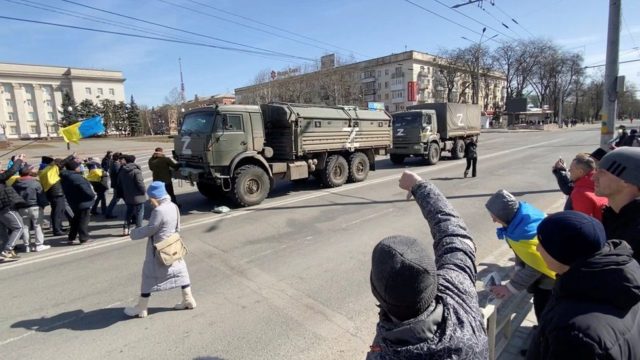
Russia Considers Annexing Ukrainian Territories Through Referendums (Part Two)
Publication: Eurasia Daily Monitor Volume: 19 Issue: 111
By:

*To read Part One, please click here.
Russia gave plenty of early warning of its intentions to keep Ukraine’s Kherson and Zaporyzhzhia regions permanently under occupation and attach them to Russia. Yet, Moscow’s multiple early warnings seemed to pass unnoticed in the West, until The White House finally noticed and spoke up (see EDM, July 21).
Moscow’s early—and continuing—warnings have addressed two primary audiences: the populations of these newly occupied territories and Western powers.
“Russia is here to stay” (or “Russia will not go anywhere from here”) is the central theme in the messaging to these territories’ populations. The approach is designed to encourage active and potential collaborators, flip fence-sitters, frighten local patriots of Ukraine into fleeing to Ukrainian government-controlled territory, discourage resistance and deprive both regions of potential local leaders.
The early warnings also served as trial balloons to test Western reactions. And indeed, Western powers failed to react at all (until The White House’s much belated July 19 statement). As a reaction of sorts, certain Western European leaders have entreated Kyiv into accepting an open-ended ceasefire along the existing front lines or ceding Kherson and Zaporyzhzhia in an eventual “peace” settlement with Russia.
The inflection point for Russia’s decision to annex Ukraine’s Kherson and Zaporyzhzhia regions came in early May 2022. This can clearly be gleaned from open-source evidence. The decision was publicly communicated from on high in the Kremlin as well as locally. It should have been easily noticed in the West but was instead ignored.
Russia’s presidential spokesman, Dmitry Peskov, issued a series of statements from May 2022 onward, urging that referendums be held in Kherson and Zaporyzhzhia to decide the status of these territories (TASS and RIA Novosti, May 7, 11, 19, 31, June 2, June 19). Peskov kept the time frame for holding these votes open but recommended that they be “impeccably” prepared. He also avoided mentioning accession to Russia in an effort to make the Russian land grab appear to be a local decision.
On the ground in Kherson and Zaporyzhzhia, however, Moscow’s official emissaries made clear from May 2022 onward that accession to Russia was the objective (TASS, RIA Novosti, May 6, 11, 19). Senior members of Russia’s bicameral parliament from the governing United Russia party presented such statements, capped by that of Federation Council Chair Valentina Matvienko, whose chamber holds the constitutional power to ratify the accession of new territories to Russia (Interfax, July 7).
While the military occupation and other “facts on the ground” in Kherson and Zaporyzhzhia heavily favor Russia, the prerequisites for staging a trouble-free referendum from Moscow’s perspective are not yet in place.
First, the civil-military administrations (CMAs, local proxies of the Russian military occupation) are far from fully established. Moscow has installed them in the city of Kherson and in Melitopol (“temporarily” there while the city of Zaporyzhzhia remains unoccupied). But the CMAs are not yet fully constituted even in those two centers, let alone at the district level and in smaller towns. The CMAs would eventually be tasked with handling the nuts and bolts for the referendums, but they need a period of Russian training for this.
Second, Russian carpetbagger officials and civil servants have yet to colonize the local administrations, infrastructure and school systems in Kherson and Zaporyzhzhia. Many of the new arrivals from Russia are stepping into posts vacated by Ukrainian loyalists who escaped likely persecution by moving to unoccupied Ukrainian territory. The Russian carpetbagger influx is already on its way but needs some more time for a complete takeover. This imported nomenklatura, ranging from senior to junior, will be crucial to holding successful “referendums.”
Third, Russia has not yet completed the twin tasks of disconnecting the Kherson and Zaporyzhzhia regions from Ukraine’s mass communications systems and connecting these regions to Russia’s systems. Moscow is well along in accomplishing these tasks but needs more time to expose both regions to the full impact of its propaganda.
Fourth, the potential for local Ukrainian resistance has manifested itself in several assassinations of CMA officials in both regions. Whether these actions were purely local in origin or assisted by the Ukrainian military is not known. Such actions thus far are sporadic, anonymous, as well as lacking any signs of organization, and they do not target Russian military directly, only local civilian collaborators. Nevertheless, these moves could be the first harbingers of an entrenched resistance that could also invite covert assistance from Kyiv. Deadly attacks on collaborators or Russian military personnel during a referendum would severely embarrass the occupying power.
Fifth, some 30 percent of Zaporyzhzhia region remains Ukrainian government-controlled, including the region’s administrative center in the city of Zaporyzhzhia. In a roughly similar situation, earlier this year, the Donetsk and Luhansk “people’s republics” have postponed their own “referendums,” pending the full conquest of Ukraine’s pre-2014 Donetsk and Luhansk regions. Also this year, Russia “recognized” those two “republics” within the pre-2014 boundaries of Ukraine’s Donetsk and Luhansk provinces. If Moscow applies the same principle to Zaporyzhzhia region (particularly considering the region’s eponymous administrative center has not yet been conquered), the Kremlin might wait for the conquest of the remainder of the region before proceeding with a referendum there.
Sixth, probing counterattacks by the Ukrainian army (even short of a full-fledged counteroffensive) could physically impede holding local referendums and embarrass the Kremlin at home and abroad. Ukrainian President Volodymyr Zelenskyy has publicly asked the Ukrainian Armed Forces to prepare for counteroffensive operations on this front.
In sum, the preconditions are not yet in place for successfully staging “referendums” from Russia’s point of view. Holding them, as has been proposed, in September 2022 would be a risky, possibly reckless decision. Moscow may well consider 2023 a more propitious time frame.



